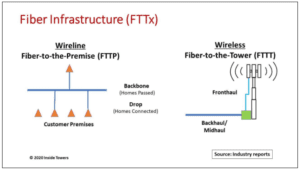The need for high-speed, near-instantaneous connectivity is escalating. Since COVID-19 hit, individuals and businesses have deemed high-speed connectivity as essential service. Reliable, secure connectivity is highly reliant on fiber optics infrastructure in both wireline and wireless networks. Fiber outperforms all other wireline and wireless alternatives.
The invention of low-loss fiber optic cable nearly 50 years ago changed everything. Voice, data, and video signals could be sent over long distances with little degradation thereby surpassing limitations of copper cable or microwave radio transmissions.
Fiber infrastructure has come in three great waves.
The first wave involved fiber for intercity long-haul transmissions that dramatically reduced long-distance calling charges. The most notable impact was the dismantling of the AT&T Long Lines microwave network that handled U.S. long-distance communications for decades. Similar impacts occurred in other countries that are now connected with global undersea fiber cable networks.
The second wave impacted connections between switching offices, both in local telco and mobile operator networks. Referred to as the transport network, these interoffice connections provided the bandwidth needed for growing broadband traffic at lower cost per bit compared to copper cable links. Importantly, fiber capacity can be increased by upgrading terminal equipment at the end of the cable without adding more cables that increase outside plant installation and maintenance costs.
The third wave involves deploying fiber in the access network, close to or at the customer premise.
The telecom vernacular added fiber-to-the-whatever, or FTTx, where ‘x’ represents the curb (FTTC), node (FTTN), home/premise (FTTH/P), a cell tower (FTTT) or small cell (FTTSC), that is, wherever the fiber cable terminates. Cable companies use a hybrid fiber coax (HFC) architecture that brings fiber from the cable head-end close to the customer, then connects to homes using existing coaxial cable.
Fiber is a growing element of wireless infrastructure especially with 5G. Where available, fiber initially provided backhaul connections from macrocells to mobile switching offices, displacing copper cable or microwave links.
Fiber-to-the-antenna or fronthaul fiber at macrocells connects baseband units on the ground with remote radio units on the tower next to antennas. With 5G, mid-haul fiber connects BBU centralized units with intermediate distributed units that connect to RRUs. Certainly, fiber connects arrays of small cells in dense metro applications.
Third wave deployments are extending over a longer time frame than the two previous waves, now completed for the most part.
Installing fiber in access networks takes significant time and money to deploy in both established and new residential neighborhoods, high rise buildings and industrial parks. The Fiber Broadband Association estimates that fiber passes nearly 40 percent of 129 million U.S. homes. That penetration is expected to reach 50 percent by 2025.
Even with demand, FTTx deployments involve significant capital expenditure. Cost per home passed can run $1,000-1,500 depending on the distance from the optical line terminal in the telco CO, whether the cable is buried or aerial, and the number of homes passed.
Cost per home connected runs another $1,200-1,300 for the dedicated fiber cable drop and an on-premise optical network terminal with multiple ports for gigabit-speed internet, phone, and TV service. Total FTTH capex can run $2,000-2,500 per subscriber, typically with 30-40 percent take rates.
Fixed wireless access such as Verizon’s 5G Ultrawideband at 28 GHz is being touted as a cost-effective alternative to fiber especially in dense applications. FWA costs per connected subscriber including cell site and customer premise equipment can be 40-50 percent lower compared to FTTH.
FWA tradeoffs are coverage and throughput, however. 28 GHz small cells have a limited operating radius and generally need a clear light-of-sight transmission path. Consequently, many nodes are needed for adequate coverage. Furthermore, FWA internet speeds are lower at several hundred Mbps versus Gbps for FTTH.
Proponents consider fiber a solution to closing the digital divide. Certainly, FTTH can deliver similar urban high-speed connectivity to residents and businesses in small towns and rural areas.
The problem is that fiber deployment costs per subscriber in rural areas can be several times higher compared to urban markets. Long cable backbone runs from COs over wide areas are needed to serve a relatively small number of subscribers.
Numerous government funding programs help service providers offset high capex.
Cost sharing is an alternative. The Public Infrastructure/Private Service model proposed by the Benton Institute for Broadband & Society advocates that municipalities install and maintain the fiber infrastructure (dark fiber, rights-of-way, conduit) while service providers install and maintain the fiber terminal electronics and connections, and handle marketing, sales, and customer service.
By John Celentano, Inside Towers Business Editor





Reader Interactions